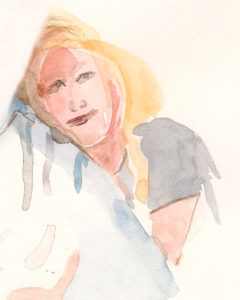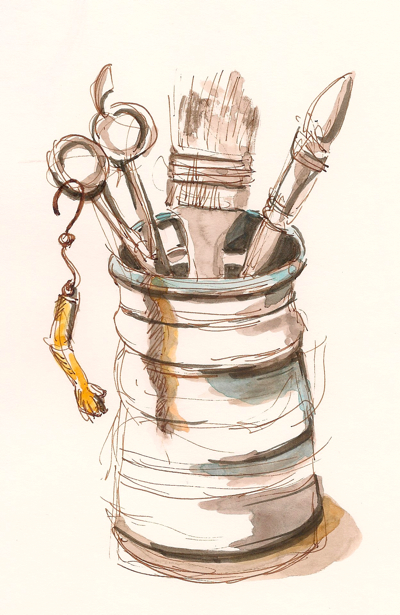Poets can open our hearts and touch us. Robert Frost does this for me in his poem ‘Birches’. The complete poem can be found at https://www.poetryfoundation.org/poems-and-poets/poems/detail/44260 or in The Poetry of Robert Frost (1969). 
When I see birches bend to left and right
Across the lines of straighter darker trees,
I like to think some boy’s been swinging them.
And then after Frost digresses about how ice storms bend the trees downwards, he continues:
By riding them down over and over again
Until he took the stiffness out of them,
And not one but hung limp, not one was left
For him to conquer. He learned all there was
To learn about not launching out too soon
And so not carrying the tree away
Clear to the ground. He always kept his poise
To the top branches, climbing carefully
With the same pains you use to fill a cup
Up to the brim, and even above the brim.
Then he flung outward, feet first, with a swish,
Kicking his way down through the air to the ground.
So was I once myself a swinger of birches.
And so I dream of going back to be.
It’s when I’m weary of considerations,
And life is too much like a pathless wood
Where your face burns and tickles with the cobwebs
Broken across it, and one eye is weeping
From a twig’s having lashed across it open.
I’d like to get away from earth awhile
And then come back to it and begin over.
May no fate willfully misunderstand me
And half grant what I wish and snatch me away
Not to return. Earth’s the right place for love:
I don’t know where it’s likely to go better.
I’d like to go by climbing a birch tree,
And climb black branches up a snow-white trunk
Toward heaven, till the tree could bear no more,
But dipped its top and set me down again.
That would be good both going and coming back.
One could do worse than be a swinger of birches.
Each of us may be touched differently by this poem. The full poem can transport us into the woods, the natural world. The description of the boy can take us back to the sense of adventure and freedom of swinging and climbing as children, and even our adventures as adults. But the poet also gives a way to think of our desires to be free of the constraints of the world, when our faces ‘burn and tickle with the cobwebs’ and ‘one eye is weeping from a twig’s having lashed across it.’ Yet, he reminds us: ‘Earth’s the right place for love.’ We launch out in this wild world that is the right place for love.
 Here are some web-links to poetry and music from the Spiritual Connection book that I gathered up to post. I hope some of them can help to provide fuel for you in these days.
Here are some web-links to poetry and music from the Spiritual Connection book that I gathered up to post. I hope some of them can help to provide fuel for you in these days.
 Grace is one of the most majestic words in theology. It suggests the sublime spontaneity of the divine which no theory or category could ever capture. Grace has its own elegance. It is above the mechanics of agenda or operation. No-one can set limits to the flow of grace. Its presence and force remain unmeasurable and unpredictable. Grace also suggests how fluent and seamless the divine presence is. There are not compartments, corners or breakages imaginable in the flow of grace. Grace is the permanent climate of divine kindness. It suggests a compassion and understanding for all the ambivalent and contradictory dimensions of the human experience and pain. This climate of kindness nurtures the sore landscape of the human heart and urges torn ground to heal and become fecund. Grace is the perennial infusion of springtime into the winter of bleakness. – (John O Donahue, Beauty, 2004, Harper Collins pg 228)
Grace is one of the most majestic words in theology. It suggests the sublime spontaneity of the divine which no theory or category could ever capture. Grace has its own elegance. It is above the mechanics of agenda or operation. No-one can set limits to the flow of grace. Its presence and force remain unmeasurable and unpredictable. Grace also suggests how fluent and seamless the divine presence is. There are not compartments, corners or breakages imaginable in the flow of grace. Grace is the permanent climate of divine kindness. It suggests a compassion and understanding for all the ambivalent and contradictory dimensions of the human experience and pain. This climate of kindness nurtures the sore landscape of the human heart and urges torn ground to heal and become fecund. Grace is the perennial infusion of springtime into the winter of bleakness. – (John O Donahue, Beauty, 2004, Harper Collins pg 228)



 I have always loved to dance, and to watch others dancing. There is something about dancing that can express joy in fantastic ways, connecting our feelings of joy to how we feel in our bodies. I have enjoyed a video recently, of the TU Dance Company in a collaboration with the singer Bon Iver, and I enjoyed sketching the dancers, entering into their experience while doing so (
I have always loved to dance, and to watch others dancing. There is something about dancing that can express joy in fantastic ways, connecting our feelings of joy to how we feel in our bodies. I have enjoyed a video recently, of the TU Dance Company in a collaboration with the singer Bon Iver, and I enjoyed sketching the dancers, entering into their experience while doing so (
 Flowers grow out of dark moments.
Therefore, each moment is vital. It affects
the whole. Life is a succession of moments and to live each, is to succeed.
Flowers grow out of dark moments.
Therefore, each moment is vital. It affects
the whole. Life is a succession of moments and to live each, is to succeed.


 As I reflected on the days here in the northern hemisphere getting darker and darker, this quote from Merton seemed just right. This is from my advent calendar (click
As I reflected on the days here in the northern hemisphere getting darker and darker, this quote from Merton seemed just right. This is from my advent calendar (click 




 “People who place their small time into the heart of eternity, which they already carry within, will suddenly realize that even small things, have inexpressible depths, are messengers of eternity, are always more than they appear to be, are like drops of water in which is reflected the entire sky, like signs pointing beyond themselves, like messengers running ahead of the message they are carrying and announcing the coming of eternity, like shadows of true reality that are cast over us because the real is already very near.”—Karl Rahner (trans. Annemarie Kidder)
“People who place their small time into the heart of eternity, which they already carry within, will suddenly realize that even small things, have inexpressible depths, are messengers of eternity, are always more than they appear to be, are like drops of water in which is reflected the entire sky, like signs pointing beyond themselves, like messengers running ahead of the message they are carrying and announcing the coming of eternity, like shadows of true reality that are cast over us because the real is already very near.”—Karl Rahner (trans. Annemarie Kidder)












